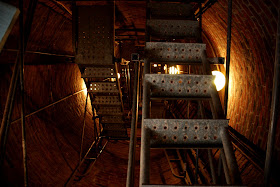
December 18, 2008 -
Manhattanville is a gritty industrial valley on the western edge of Harlem. Situated underneath multiple overpasses, including the famed Riverside Drive Viaduct, the neighborhood is a colorful collection of auto body shops, stone & marble fabricators, boiler repairmen and meat wholesalers. In recent years, its cobblestone streets have experienced a growing popularity, with a new Fairway Market and restaurants like Dinosaur BBQ drawing in crowds.
Columbia University plans to demolish 17 acres of this busy neighborhood. They will replace them with a huge new $7 billion extension campus. As part of this plan, Manhattanville was declared blighted in 2008 by the Empire State Development Corporation, opening the door for government use of eminent domain to seize the property of any businesses that did not wish to relocate. Like the radical transformation being forced upon the industrial businesses of the Iron Triangle, this plan was met with much protest, but to date, only three businesses continue to hold out against Columbia - a gas station and two storage companies.
Work has already begun on on Phase 1 of Columbia's plan, which will remove a city block between 129th and 130th Street west of Broadway. Several businesses in this block, including a service station and parking lot, have already closed their doors. Popular restaurants like Dinosaur BBQ and Floridita will be displaced. The prematurely quieted streets of Phase 1 are now watched over by dozens of security cameras.
---
For more photo essays on neighborhoods endangered by eminent domain, please visit The Bloomberg Era, Part Two (2010), The Demolition of Manhattanville (2011), The Iron Triangle (2008), and The Atlantic Yards (2007).

















































